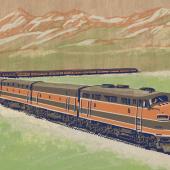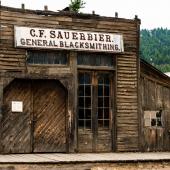Montana Town - Virginia City
Where the Footprints of the Past Meet the Present...
High above Virginia City, Montana, lies a wagon-rutted stretch of the old Bozeman Road. It once wound from the north hills down into the town. The route carried sojourners and travelers by the thousands who came from every corner of the world to try their luck, to make a buck, to capture a piece of legendary Alder Gulch.

Nestled among the rugged peaks and gentle valleys of Madison County, the treasure trove of Alder Gulch yielded an estimated thirty million dollars within five years of the discovery. Whether snow dusts the ground or heat waves play along the wooden sidewalks, the little hamlet is a town for all seasons preserving the West as it was, and still is. Panoramic vistas and pristine landscapes, landmarks and architecture you won’t see elsewhere, artifacts from corsets to Chinese groceries, and people who appreciate their historic surroundings make Virginia and Nevada cities worth exploring. The special ambience is what makes the traveler want to return and the native-born never want to leave.
Virginia City’s importance to the settling of the western frontier was enormous. National Trust for Historic Preservation president Richard Moe likens its role to Colonial America’s Williamsburg. But the placer gold played out, miners moved on, and the railroad passed it by. Designated a National Historic Landmark in 1961, more than a thousand buildings and temporary structures once crowded the original Virginia City town site. Today, less than a quarter remain. Of these survivors, some fifty buildings represent the height of the gold rush from 1863 to 1865. They are an extraordinary tribute to a fleeting period in the settlement of the American West.
Discovery men Bill Fairweather, Barney Hughes, and Henry Edgar panned the first gold in the alder-choked streambed on May 26, 1863. Miners stripped the hillsides to build built cabins and sluice boxes. Ten thousand people soon crowded into nine boomtowns along a fourteen-mile stretch. Of these, Virginia City and its nearby twin, Nevada City, were the largest. Missouri miner James Morley, summed up the high excitement. “Truth and the marvelous go hand in hand,” he wrote, “when Young America finds a good gold gulch.”
A miners’ court organized to handle claim disputes and legal issues. But the free-flowing gold dust and rough population bred more violence than it could handle. From December 1863 to March 1864, self-proclaimed lawmen hanged some twenty-four men. Creation of the Territory of Montana, on May 26, 1864—the first anniversary of the Alder Gulch discovery— brought a federal presence, ending local vigilante hangings.
Virginia City quickly rose to become the territory’s social, commercial, and transportation hub while Nevada City declined. In 1865 the territorial capital moved from Bannack to Virginia City. Regular stages ferried passengers to Salt Lake City, the Montana Post kept the population informed, and seventy licensed liquor dealers quenched the miners’ thirst. A decade later, the proposed railroad route bypassed Virginia City but favored Helena. The territorial capital and government officials moved there in 1875. Although still the Madison County seat, the advent of the railroad in the 1880s ended Virginia City’s reign as a regional supply center.
Thanks to Montana’s dry climate, no termites, and a miraculous lack of destructive fires—the bane of every mining town—much of Wallace Street remains as it was when fickle fortune lured its population elsewhere. The false-fronted wooden buildings with their French doors and small panes of wavy glass—packed in sawdust and freighted in by ox team—never saw remodeling. These are Virginia City’s most enduring and endearing features.
From the 1890s through the depression years, Virginia City housed and fed gold dredging crews. The Gold Mine Closing Order ended dredging in 1942. A handful of residents refused to leave Virginia City to the ghosts of its storied past; the future was grim.
In the fall of 1944, newly elected Great Falls legislator Charles Bovey and his wife, Sue, visited Virginia City. Infatuated with the history of Alder Gulch, the Boveys began acquiring Virginia City’s derelict buildings. Bovey stabilized some buildings, adapted others, and built new structures to look old. He also acquired Nevada City’s few remaining buildings and moved endangered historic structures from across the state along its streets. He and Sue combed the country for artifacts, filling their buildings with collections of every category imaginable.
Charles Bovey died in 1978 and Sue in 1988, having added their own historic layers. The heirs, unwilling to continue the enterprise, placed a multi-million dollar price tag on the properties. The State of Montana purchased more than 250 buildings in 1997, creating the Montana Heritage Commission (MCH) to manage them. Under the Department of Commerce, a staff of ten now works at Virginia City. The Commission’s preservation team works with the National Park Service, the State Historic Preservation Office, and others to protect and preserve the fragile landmarks. Leaky sagging roofs, crumbling foundations, rotting wood, and deterioration are the real demons among Virginia City’s ghosts. Below ground, archaeological layers—essential to the story—compound the intricate history. Thousands upon thousands of artifacts crowded into the delicate buildings pose daunting curatorial and interpretive challenges.
Archeology, preservation, and collection management are invisible yet essential tasks. Thanks to a private donor, the McFarland Curatorial Center provides storage and workspace while National Park Service grants have financed preservation projects. The Sauerbier Blacksmith Shop, typical of the multiple uses of Virginia City’s buildings, began as an 1863 miner’s cabin. Later a dance hall and then a blacksmith shop, it was near collapse. After archeological testing, the crew installed new footings below the floor. A waterproof membrane under the roof and a mortise and tenon infrastructure stabilized the building leaving its weathered appearance intact. The project cost $80,000. New infrastructure also preserves the historic sags of the 1864 Kiskadden Barn but makes it safe for visitors to walk inside. Because the MCH preservation crew did the work, the cost was about $140,000, half that of a private contractor.
Virginia and Nevada cities’ overwhelming needs offer a fabulous training venue. The preservation team’s Historic Preservation Institute teaches others to care for and preserve log walls, windows, doors, vintage roofs, and historic masonry. The Institute strives to provide needed work on its own state properties while generating revenue.
Virginia City’s citizens share the responsibility that comes with its history, caring for their resources. The Virginia City Preservation Alliance (VCPA) contributes tremendously and always welcomes new members and volunteers. Through gifts, grants, and programs, the group acquired and rehabilitated the Hangman’s Building where vigilantes simultaneously hanged five suspected road agents in January of 1864. Visitors can now explore the building and see the very roof beam that held the hangman’s ropes. The building is also a significant African American heritage site where Virginia City Water Company owner Sarah Bickford ran the utility from 1900 to the 1930s.
Private property owners also do their part. The 1864 Creighton Stone Block, for example, is a centerpiece along the east end of Wallace Street. It appears prominently in the earliest sketches of Virginia City. Brothers John and Edward Creighton planted the first telegraph pole at its corner in 1866, linking the isolated territory to the States. The family later endowed Creighton University. The building with its nine arched openings has been beautifully restored.
May to September transforms the gulch into a vacation destination. Horseback riding, a trip by stagecoach, and an expedition on the Alder Gulch Short Line Railroad through real gold country are journeys through transportation history. A 1941 fire truck—a concession to the automotive age—takes passengers on an entertaining tour of Virginia City’s landmarks and lore. On special days, a restored 1910 Baldwin No.12 steam locomotive pulls the railroad cars. Its presence is a strange reminder that the railroad furthered Virginia City’s demise.
Along Wallace Street are shops of vintage clothing, Montana-made products, one-of-a-kind treasures, an old-fashioned candy store, and several museums. The unpaved back streets, a conglomerate of modest cottages and lovely Victorian homes—some offering overnight accommodations— recall another era. On summer evenings, strains of the melodrama at the Opera House filter through the air. Its Virginia City Players are Montana’s oldest professional theater troupe. At the other end of town, the sounds of laughter and applause from the Follies at the historic Gilbert Brewery drift across the gulch. The annual Grand Ball, an August event, is a favorite topic all year long. Participants hone their dancing skills at pre-ball workshops and later promenade along the wooden sidewalks in period finery.
Take the train to Nevada City where every building has its own story. Fort Benton’s Sullivan Saddlery, with its saddle-making equipment and a rocking chair where Charlie Russell spun yarns, was the site of an important treaty with the Blackfeet in 1865. The beautifully furnished period home of territorial legislator Oscar Sedman is a focal point. The Music Hall features a world-class collection of music machines from player pianos to the world-renowned Gavioli Military Band Organ. The Star Bakery, an original 1863 Nevada City building, and the Nevada City Hotel offer bread and board.
Although the vigilantes’ deeds at Alder Gulch are one small notch in a long timeline, these incidents and associated landmarks draw tourists. During the summer months, living history at Nevada City educates the public through reenactments of the famous trial of George Ives, catalyst to the forming of the vigilantes in December 1863, and other dramatic events.
Both towns are appealing to Hollywood with ready-made sets for filming. “Return to Lonesome Dove,” “Little Big Man” starring Dustin Hoffman, “The Missouri Breaks” with Marlon Brando and Jack Nicholson, and “1,000 Pieces of Gold” — a critically acclaimed story of the Chinese experience in the West — were filmed at Virginia and Nevada cities. Nevada City was also the training ground for the three families in the television series “Frontier House”; the contents of their cabins form a museum in itself.
During the colder winter months, Virginia City’s hospitality remains warm. A weekday farmer’s market features bread baked in a handcrafted outdoor oven and lively conversation. The slower pace of the off-season allows welcome solitude to explore the nooks and crannies that make Virginia City unique.
Hike up to Boot Hill where five wooden headboards recall the dark period when the vigilantes did their work. The five outlaws’ graves lay unmarked until 1907. Local legend has it that Mayor James Walker partially exhumed Clubfoot George Lane following the directions of a witness to the burials; his misshapen foot identified him and allowed Walker to correctly identify the five graves. The foot, with a piece of sock still attached, is just one of Virginia City’s odd marvels on display at the local Thompson-Hickman Museum.
The frenzy of the gold rush worked its way into the buildings and open spaces of Alder Gulch. That residual energy makes it the haunted capital of Montana. Evening “ghost walks” are a popular activity during tourist season, but you can take your own haunted tour in the quiet of a winter afternoon. Follow the north ridge, back toward the section of the Bozeman Road. Stop at Hillside Cemetery where the nameless and the famous lie beneath the sod. Enjoy the sweeping view, and pause to consider the currents of the past.
The vigilantes’ hanging of Jack Slade was the last in Virginia City. Slade tried the patience of the community with his drunken carousing and paid the ultimate price on a cold March day in 1864. Someone rode out to the Slades’ ranch north of town to warn his wife, Virginia. As vigilantes strung Slade up on a corral gate, they heard her black thoroughbred thundering down the hill. Virginia emerged in a swirl of snow, brandishing her revolver, just moments too late.
Even today, the wind carries sounds—imprints of the past—that linger on the lonely ridge above Virginia City. If you concentrate, you might hear ghostly hoofbeats pounding down the road behind you. All you have to do is listen.
~ Ellen Baumler is the Montana Historical Society’s interpretive historian and best known for her well-researched stories of things that go bump in the night. Her most recent book, Beyond Spirit Tailings: Montana’s Mysteries, Ghosts, and Haunted Places, is now on CD with a musical score by Montana’s world-class composer/pianist Philip Aaberg.












Leave a Comment Here